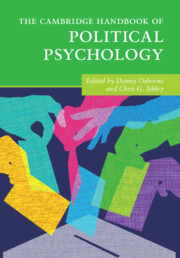Book contents
- The Cambridge Handbook of Political Psychology
- The Cambridge Handbook of Political Psychology
- Copyright page
- Dedication
- Contents
- Figures
- Tables
- Contributors
- Part I Foundations of Political Psychology
- Part II The Politics of Intergroup Attitudes
- 11 Authoritarianism
- 12 A Political Psychology of Ethnocentrism
- 13 Collective Narcissism
- 14 Demographic Change, White Decline, and the Changing Nature of Racial Politics in Election Campaigns
- 15 Macro-diversity and Intergroup Attitudes
- 16 The Persistence of Gender in Campaigns and Elections
- 17 The Politics of Abortion, Pregnancy, and Motherhood
- 18 Religiosity and Openness to Authoritarian Governance
- 19 The Consequences of Moral Conviction in Politics
- 20 The Political Psychology of National Identity
- 21 The Political Dynamics of Immigration Opinion Worldwide
- 22 International and Individual Differences in Support for Human Rights
- Part III Contemporary Challenges to Democracy
- Part IV Diversifying Perspectives in Political Psychology
- Index
- References
17 - The Politics of Abortion, Pregnancy, and Motherhood
from Part II - The Politics of Intergroup Attitudes
Published online by Cambridge University Press: 17 February 2022
- The Cambridge Handbook of Political Psychology
- The Cambridge Handbook of Political Psychology
- Copyright page
- Dedication
- Contents
- Figures
- Tables
- Contributors
- Part I Foundations of Political Psychology
- Part II The Politics of Intergroup Attitudes
- 11 Authoritarianism
- 12 A Political Psychology of Ethnocentrism
- 13 Collective Narcissism
- 14 Demographic Change, White Decline, and the Changing Nature of Racial Politics in Election Campaigns
- 15 Macro-diversity and Intergroup Attitudes
- 16 The Persistence of Gender in Campaigns and Elections
- 17 The Politics of Abortion, Pregnancy, and Motherhood
- 18 Religiosity and Openness to Authoritarian Governance
- 19 The Consequences of Moral Conviction in Politics
- 20 The Political Psychology of National Identity
- 21 The Political Dynamics of Immigration Opinion Worldwide
- 22 International and Individual Differences in Support for Human Rights
- Part III Contemporary Challenges to Democracy
- Part IV Diversifying Perspectives in Political Psychology
- Index
- References
Summary
Pregnancy and motherhood are among the most cherished experiences of many women, but for many others are involuntary or unwanted. In either case, they are ideologically loaded and politically consequential. We review various lines of research across the social sciences documenting some of the myths surrounding pregnancy and motherhood, and some of the taboos, restrictions, and discrimination to which pregnant women and mothers are subjected.Our review encompasses opposition to abortion, ‘financial abortion’, paternalistic control over women’s reproductive and lifestyle choices, the motherhood penalty, and antagonism to women’s autonomy in conservative, libertarian, and populist politics. Drawing on social psychological theory, we argue that these phenomena have obvious roots in male dominance but also in idealised, reverential attitudes to pregnancy and motherhood. We conclude that unchecked, they will prevent women from achieving economic and social parity with men.
- Type
- Chapter
- Information
- The Cambridge Handbook of Political Psychology , pp. 272 - 283Publisher: Cambridge University PressPrint publication year: 2022
References
- 4
- Cited by



